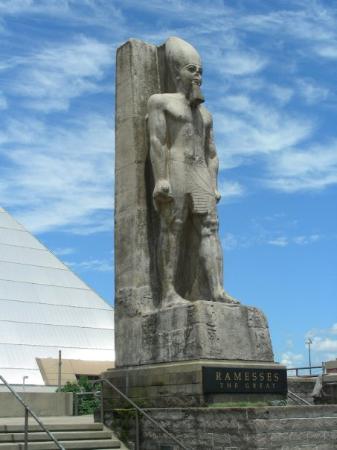Pyramid and view of Wolf River
The Memphis Pyramid has not been regularly used as a sports or entertainment venue since 2004. In 2015, the Pyramid re-opened as a Bass Pro Shops "megastore", which includes shopping, a hotel, restaurants, a bowling alley, and an archery range with an outdoor observation deck at its apex.
Riverside Drive Entering Ramp of I-40 to Arkansas With View Of Pyramid
Construction:

This photo of Bass Pro Shop is courtesy of TripAdvisor
The "Great American Pyramid" was conceived originally by Mark C.
Hartz, a Memphis artist in about 1954. The project originally included
three pyramids located on the south bluffs of Memphis overlooking the Mississippi River. The larger of the three would have been 2/3rd scale of the Great Pyramid of Memphis, Egypt.
Because the flanking structures would have been scaled at 2/3s the size
of the main pyramid. The project languished for three decades until
Mark's younger son, Memphian Jon Brent Hartz, resurrected the concept.
Mark C. Hartz, who was well known for his architectural renderings,
rendered a new bronze glass-glazed pyramid. After years of negotiations,
the younger Hartz's concept was adopted by entrepreneur John Tigrett as
a symbol for the city of Memphis. The groundbreaking ceremony was held
on September 15, 1989 and the building was opened on November 9, 1991.
The construction of the building was managed by Sidney Shlenker, part
owner of the Denver Nuggets
and several entertainment companies, who Tigrett had brought to Memphis
to develop tourist attractions in the building. Originally, there were
plans for a shortwave radio station broadcasting Memphis music, an observation deck with an inclinator along the side of the building, a Hard Rock Cafe,
a music museum, and a theme park on Mud Island along with other things.
However, the plans were scrapped because of a fallout between Tigrett
and Shlenker and the latter's financial difficulties.
View Of Pyramid From Mud Island and Downtown Memphis
Various Former Uses And Events:
The Pyramid was the home court for the University of Memphis men's basketball program, and later for the National Basketball Association's Memphis Grizzlies. However, both teams left The Pyramid in November 2004 to move into the newly built FedExForum. It was also home to the Memphis Pharoahs of the AFL.The arena hosted the 1993 Great Midwest Conference Men's and Women's basketball tournaments, the 1994 and 1997 Southeastern Conference men's basketball tournament, the 1996 and 2000 Conference USA men's basketball tournament, and the 2003 Conference USA women's basketball tournament. It also held the first and second rounds of the NCAA Tournament in 1995, 1997, and 2001.
Pyramid Just Past Auction Bridge To Mud Island
The Pyramid was the site of the WWF St. Valentine's Day Massacre: In Your House pay-per-view, in 1999.
It also hosted the boxing mega-fight between Lennox Lewis and Mike Tyson in 2002, which Lewis won by a knockout in the eighth round.
Hernando Desoto Bridge beside Pyramid (The "M" Bridge)
Filmmaker Craig Brewer used the building as a sound stage for his film Black Snake Moan in late 2005.
Hernando Desoto Bridge Night View Overlooking Mud Island
From 2002 to 2006, the annual Church of God in Christ international holy convocations were held here.
In 2002, the arena hosted a concert, commemorating the 25th anniversary of Elvis Presley's death.
Bob Seger & The Silver Bullet Band performed what is reputed to be the last concert ever in the Pyramid, on February 3, 2007.
Troubles And Closure:
The vacant Pyramid pictured in 2010.
Tom Lee Park and Riverside Drive and View Of Downtown with Pyramid at far Left.
The City of Memphis contract with the Memphis Grizzlies forbade the use of The Pyramid without the team's approval, and as a result, it went dark. A committee headed by Memphis businessman Scott Ledbetter studied possible uses of the arena in 2005, and considered such uses as converting the arena into a casino, an aquarium, a shopping mall, or an indoor theme park. In November 2006, Congressman-Elect Steve Cohen (D-Tennessee) suggested that he would attempt to open a "Mid-American branch" of the Smithsonian Institution in the building. However, these plans were never realized. In the end, the committee on the building's future recommended that it be used for "destination retail" which would create more jobs and new tax revenues.
Riverside Drive and View Of Downtown Memphis With Pyramid on Left at Wolf River Harbor
Imagery:
In 2011, a drawing of The Pyramid – alongside images of iconic structures from Tennessee's three other large cities (the AT&T Building in Nashville, Knoxville's Sunsphere, and the Tennessee Aquarium of Chattanooga) – was incorporated into the standard design of Tennessee's state-issued driver's licenses.Future Use:
In October 2005, media speculation began to focus on an aquarium or a Bass Pro Shops superstore as the most likely long-term tenants of the arena. In 2008, the city and Bass Pro Shops reached a "tentative" agreement, short on details, but based on an intent to develop the then-abandoned structure. On June 30, 2010, after 5 years of negotiating, Bass Pro and the City of Memphis signed an agreement for a 55-year lease for a Bass Pro Shops megastore. In addition, the redevelopment plans include revitalizing the Pinch District, which is the neighborhood east of the Pyramid. The city invested $30 million to help with the seismic retrofitting of the structure which was funded by sales tax revenue in the surrounding area. Bass Pro began renovations and construction in October 2012 and opened to the public on April 29, 2015.
Source: wikipedia












